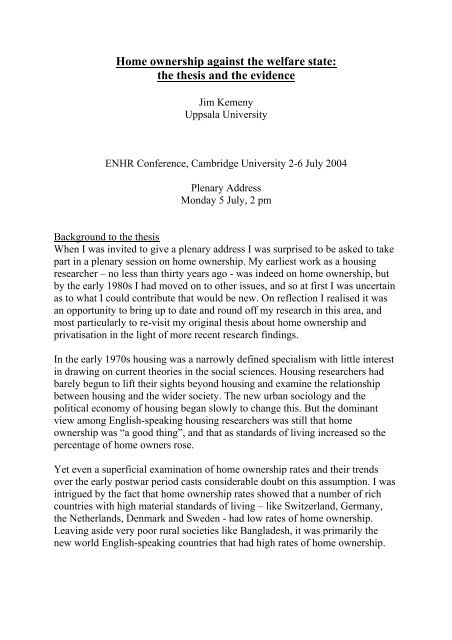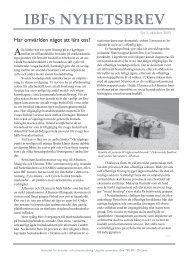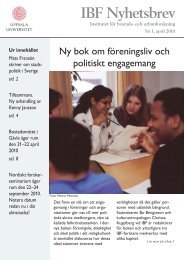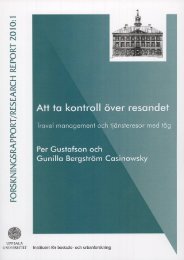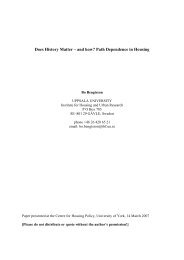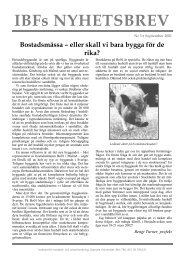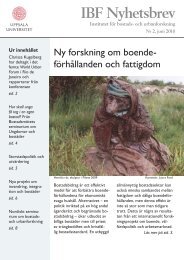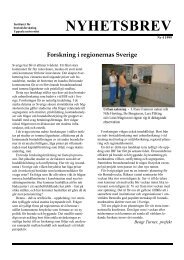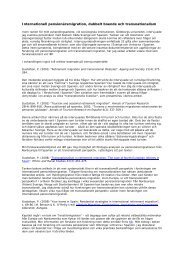Home ownership against the welfare state: the thesis and the evidence
Home ownership against the welfare state: the thesis and the evidence
Home ownership against the welfare state: the thesis and the evidence
You also want an ePaper? Increase the reach of your titles
YUMPU automatically turns print PDFs into web optimized ePapers that Google loves.
<strong>Home</strong> <strong>ownership</strong> <strong>against</strong> <strong>the</strong> <strong>welfare</strong> <strong>state</strong>:<strong>the</strong> <strong>the</strong>sis <strong>and</strong> <strong>the</strong> <strong>evidence</strong>Jim KemenyUppsala UniversityENHR Conference, Cambridge University 2-6 July 2004Plenary AddressMonday 5 July, 2 pmBackground to <strong>the</strong> <strong>the</strong>sisWhen I was invited to give a plenary address I was surprised to be asked to takepart in a plenary session on home <strong>ownership</strong>. My earliest work as a housingresearcher – no less than thirty years ago - was indeed on home <strong>ownership</strong>, butby <strong>the</strong> early 1980s I had moved on to o<strong>the</strong>r issues, <strong>and</strong> so at first I was uncertainas to what I could contribute that would be new. On reflection I realised it wasan opportunity to bring up to date <strong>and</strong> round off my research in this area, <strong>and</strong>most particularly to re-visit my original <strong>the</strong>sis about home <strong>ownership</strong> <strong>and</strong>privatisation in <strong>the</strong> light of more recent research findings.In <strong>the</strong> early 1970s housing was a narrowly defined specialism with little interestin drawing on current <strong>the</strong>ories in <strong>the</strong> social sciences. Housing researchers hadbarely begun to lift <strong>the</strong>ir sights beyond housing <strong>and</strong> examine <strong>the</strong> relationshipbetween housing <strong>and</strong> <strong>the</strong> wider society. The new urban sociology <strong>and</strong> <strong>the</strong>political economy of housing began slowly to change this. But <strong>the</strong> dominantview among English-speaking housing researchers was still that home<strong>ownership</strong> was “a good thing”, <strong>and</strong> that as st<strong>and</strong>ards of living increased so <strong>the</strong>percentage of home owners rose.Yet even a superficial examination of home <strong>ownership</strong> rates <strong>and</strong> <strong>the</strong>ir trendsover <strong>the</strong> early postwar period casts considerable doubt on this assumption. I wasintrigued by <strong>the</strong> fact that home <strong>ownership</strong> rates showed that a number of richcountries with high material st<strong>and</strong>ards of living – like Switzerl<strong>and</strong>, Germany,<strong>the</strong> Ne<strong>the</strong>rl<strong>and</strong>s, Denmark <strong>and</strong> Sweden - had low rates of home <strong>ownership</strong>.Leaving aside very poor rural societies like Bangladesh, it was primarily <strong>the</strong>new world English-speaking countries that had high rates of home <strong>ownership</strong>.
Origins of <strong>the</strong> <strong>the</strong>sisAs a sociologist I was primarily interested in exploring <strong>the</strong> privatising impact ofhome <strong>ownership</strong> on indusstrialised society as a whole. My starting point was toquestion <strong>the</strong> assumed relationship between home <strong>ownership</strong> <strong>and</strong> high materialst<strong>and</strong>ards of living. I <strong>the</strong>n began to develop a critique of <strong>the</strong> one-sided policyemphasis on home-<strong>ownership</strong> that was responsible for <strong>the</strong> creation of what Itermed “monotenural housing systems” that had, I argued, privatising effects(Kemeny, 1981, 1983).My overall argument was that home <strong>ownership</strong> impacted on society in a widerange of privatising ways, including urban form, public transport, life-styles,gender roles, systems of <strong>welfare</strong> <strong>and</strong> social security as well as o<strong>the</strong>r dimensionsof social structure. I argued that it created a lifestyle based on detached housing,privatised urban transport based on private car <strong>ownership</strong>, a traditional gendereddivision of labour based on housewifery, <strong>and</strong> strong resistance to publicexpenditure that necessitated high taxes which made buying <strong>and</strong> maintainingsuch a lifestyle more difficult. As a consequence, societies in which home<strong>ownership</strong> became <strong>the</strong> normal tenure for all but <strong>the</strong> poorest households woulddiffer considerably from societies in which renting was made attractive enoughso that significant numbers of middle-income <strong>and</strong> higher-income householdschose to rent.In countries where long-term housing policy strategies have structured <strong>the</strong> rentalmarket in such a way as to make renting unattractive - even repellent - as alifelong housing commitment, <strong>the</strong>re is a mad scramble among <strong>the</strong> young toescape out of renting or even avoid having to rent at all, not even as an interludebetween <strong>the</strong> parental home <strong>and</strong> first home.One of <strong>the</strong> most interesting characteristics of home <strong>ownership</strong> is <strong>the</strong> way itredistributes income within <strong>the</strong> life-cycle of individuals from youth to old age.This redistribution often begins with saving for a deposit, sometimes long beforebecoming a first-time buyer <strong>and</strong> while living in rental housing or even in <strong>the</strong>parental home. It continues with cripplingly high mortgage repayments intomiddle age. In countries with an extreme emphasis on home <strong>ownership</strong>, such asIcel<strong>and</strong> where 70 percent of households are home owners, such a parentaldependency phase of life can extend well into <strong>the</strong> thirties in a phenomenon thathas come to be known as “Hotel Mamma” (Sveinsson, 1999).Given that <strong>the</strong> mortgage burden on first-time buyers can consume up to a thirdof household income, while an elderly household in a mortgage-free home thatneglects maintenance – not to mention minimal prevention of normal structuraldeterioration - can push housing costs down to little more than heating costs, <strong>the</strong>life cycle redistributive impact of home <strong>ownership</strong> can be very substantial. This
in turn raised interesting questions as to whe<strong>the</strong>r this income-redistributiveeffect is sufficient to create a symbiotic relationship between home <strong>ownership</strong><strong>and</strong> <strong>welfare</strong>. I suggested that it was sufficient.The ThesisThe <strong>the</strong>sis was initially developed in <strong>the</strong> Australian context during <strong>the</strong> late 1970swhile I lived <strong>the</strong>re (Kemeny, 1977, 1980a) but became more generalised in mycomparative work (Kemeny, 1978, 1980b, 1981). I argued that in societes withlow public retirement pensions <strong>and</strong> poor <strong>welfare</strong> provision for <strong>the</strong> elderly,households are forced to make private provision for <strong>the</strong>ir old age. That is, <strong>the</strong>yare forced to devote resources already in early adulthood to ensure levels ofprivate savings so that personal capital can be accummulated to secure <strong>the</strong>ir oldage. There are many ways this can be done, including private pension schemesor building up a nest egg in <strong>the</strong> form of ei<strong>the</strong>r a savings account or stock marketshares. Among <strong>the</strong>se choices is also a decision to become a home owner in <strong>the</strong>expectation of having low housing costs in old age to eke out <strong>the</strong> public pension,<strong>and</strong> even trading down to release savings to supplement meagre pensions.In countries where policy encourages this strategy paying for a home - <strong>and</strong> oftena car as well - will act as a strong deterrent to <strong>welfare</strong> <strong>and</strong> social security fundedby increasing taxation.I <strong>the</strong>refore posited a negative relationship between home <strong>ownership</strong> <strong>and</strong> <strong>welfare</strong>,focusing on 8 OECD countries: three with low home <strong>ownership</strong> rates (Sweden,West Germany <strong>and</strong> The Ne<strong>the</strong>rl<strong>and</strong>s), two with average home <strong>ownership</strong>s rates(UK <strong>and</strong> France) <strong>and</strong> three with high home <strong>ownership</strong> rates (USA, Canada <strong>and</strong>Australia). I compared <strong>the</strong>se countries in terms of three very general aggregateindices of <strong>welfare</strong> (current government expenditure as a percent of GNP, totaltaxation as a percent of GNP, <strong>and</strong> percent of income paid in direct taxes)Without doing any statistical tests on <strong>the</strong>se data <strong>the</strong>y never <strong>the</strong> less did suggestthat <strong>the</strong>re was a negative relationship between home <strong>ownership</strong> rates <strong>and</strong><strong>welfare</strong> provision (Kemeny, 1980 Table 1).I followed this with a somewhat closer examination of three countriesrepresenting <strong>the</strong> extremes <strong>and</strong> <strong>the</strong> middle, comparing one country with a highhome <strong>ownership</strong> rate (Australia), one with a medium home <strong>ownership</strong> rate (UK)<strong>and</strong> one with a low home <strong>ownership</strong> rate (Sweden). The differences appeared tobe very suggestive of a negative correlation between home <strong>ownership</strong> <strong>and</strong><strong>welfare</strong> (Table 1).
Table 1<strong>Home</strong> <strong>ownership</strong> rates <strong>and</strong> social security in Australia, Britain <strong>and</strong> SwedenCountry Australia Britain Sweden<strong>Home</strong> <strong>ownership</strong>Rate 1970-71 68 55 35Govt finalConsumption 24 33 47Expenditure as% of totalper capita govtexpenditure onsocial <strong>welfare</strong> & 300 500 650health (US$)<strong>state</strong> married retirementpensions as 26 30 66% of average incomeUnemploymentbenefits as % of 23 38 82average weeklyearningsSource: Kemeny, 1980b Table 2But, of course, data from three countries are quite inadequate to test <strong>the</strong> <strong>the</strong>sis.More complex statistical analysis would be needed to provide an initial test.The years went by, but <strong>the</strong> ideas were nei<strong>the</strong>r taken up nor tested by housingresearchers <strong>and</strong> it appeared that <strong>the</strong>re was no interest in pursuing it. I was<strong>the</strong>refore surprise when twenty years later <strong>the</strong> <strong>the</strong>sis was subjected to ten-yearinterval correlation analysis using OECD statistics – not, I have to stress, by ahousing researcher but by a comparative <strong>welfare</strong> researcher. Even in <strong>the</strong> late1990s research on <strong>the</strong> relationship between housing <strong>and</strong> <strong>welfare</strong> remainsdisgracefully under-developed.The <strong>evidence</strong>My <strong>the</strong>sis was tested by Castles (1996, 1998), a political scientist by trainingwho at <strong>the</strong> time was professor of public policy at <strong>the</strong> Australian NationalUniversity. Castles conducted a statistical analysis of <strong>the</strong> relationship betweenrates of home <strong>ownership</strong> <strong>and</strong> various indices of public <strong>welfare</strong> in 20 OECDcountries. He examined <strong>the</strong>se at four-decade intervals: 1960, 1970, 1980 <strong>and</strong>1990. He found that, with <strong>the</strong> exception of public health, <strong>the</strong>re were strong to
moderately-strong inverse relationships between various indices of <strong>welfare</strong> <strong>and</strong>rates of home <strong>ownership</strong> in 1960, <strong>and</strong> that although <strong>the</strong>y gradually weakenedover <strong>the</strong> ensuing decades, <strong>the</strong>y were still evident in 1990. Table 2 summarises<strong>the</strong>se findings.Table 2CORRELATIONS BETWEEN HOME OWNERSHIP LEVELS ANDMEASURES OF GOVERNMENT REVENUES ANDEXPENDITURES 1960-1990Revenues Outlays total social protection expenditure1960 -.79* -.76*** -.75***1970 -.61*** -.61*** -.81***1980 -.68*** -.59** -.76***1990 -.52** -.54** -.54**The number of asterisks indicate different significance levels:* = < 0.1** =
more generally termed a divergence perspective on housing <strong>and</strong> <strong>welfare</strong>(Kemeny, 1992: 181-186, Kemeny <strong>and</strong> Lowe, 1998).Castles is critical of what he underst<strong>and</strong>s as my implicit one-sided focus on <strong>the</strong>impact of home-<strong>ownership</strong> on <strong>welfare</strong>, <strong>and</strong> suggests <strong>the</strong> relationship is morecomplex. He concludes his article:“Finally, <strong>the</strong> assumption implicit in Kemeny’s work <strong>and</strong> much of what is said above is that<strong>the</strong> extent of home <strong>ownership</strong> impacts on <strong>the</strong> form of <strong>the</strong> <strong>welfare</strong> <strong>state</strong>. But that is only oneway of reading <strong>the</strong> coefficients reported in Table 2. There is no a priori reason why <strong>the</strong>relationship may not be entirely <strong>the</strong> o<strong>the</strong>r way around, with a weak <strong>welfare</strong> <strong>state</strong> providing anincentive to home <strong>ownership</strong> as a means of life cycle saving or a well developed <strong>state</strong> taxcrowding out <strong>the</strong> possibility of saving for private home <strong>ownership</strong>. To establish a betterunderst<strong>and</strong>ing of <strong>the</strong> diverse linkages which undoubtedly exist between what are, from <strong>the</strong>point of view of individuals <strong>and</strong> families, <strong>the</strong> largest expences <strong>the</strong>y confront – providing forold age <strong>and</strong> providing for shelter – requires much fur<strong>the</strong>r research.” (Castles, 1998: 17-18)I would fully agree with this. In <strong>the</strong> late 1970s I was not concerned wi<strong>the</strong>xplaining <strong>the</strong> direction of <strong>the</strong> relationship, only that it exists. Ra<strong>the</strong>r I wasconcerned to explain differences in urban form, gender roles, <strong>welfare</strong> <strong>and</strong> o<strong>the</strong>raspects of privatisation between home-owning societies like Australia <strong>and</strong>renting societies like Sweden.Now things are, of course, much changed. In <strong>the</strong> wake of <strong>the</strong> oil crisis of <strong>the</strong> 70s<strong>and</strong> <strong>the</strong> resurgence of reactionism in <strong>the</strong> 80s, <strong>the</strong> privatisation of <strong>welfare</strong> inmany countries is opening up <strong>the</strong> possibility that even <strong>the</strong> most stable <strong>welfare</strong><strong>state</strong>s may begin to witness a shift to home <strong>ownership</strong> as ordinary people lookfor ways to minimise <strong>the</strong> looming threat of poverty <strong>and</strong> deprivation in old age. Itis <strong>the</strong>refore of some interest to briefly revisit <strong>the</strong> <strong>the</strong>sis in relation todevelopments in Swedish <strong>welfare</strong> for <strong>the</strong> elderly over <strong>the</strong> last decade.The end of <strong>the</strong> Swedish security <strong>welfare</strong>: a predictionSince <strong>the</strong> mid-1990s <strong>the</strong>re has been a dramatic deterioration in public <strong>welfare</strong>for <strong>the</strong> elderly in Sweden. This is most noticeable in two key areas – pensions<strong>and</strong> institutional care - retirement homes <strong>and</strong> nursing homes - for <strong>the</strong> elderly.In <strong>the</strong> mid-1990s <strong>the</strong> pension system – called ATP - introduced in <strong>the</strong> 1970s wasscrapped. The ATP was an unusually secure <strong>and</strong> advantageous pension system.It was index-linked <strong>and</strong> easy to calculate: you would receive <strong>the</strong> full pensionafter 15 years employment <strong>and</strong> it would amount to 80 percent of <strong>the</strong> incomeearned calculated as an average of <strong>the</strong> best 5 of those years: more if <strong>the</strong> pensionfunds prospered.
In its place was put a pension system which was both much advantageous <strong>and</strong>less transparent. The message that <strong>the</strong> social democratic government was givingwas crystal clear: <strong>the</strong> new pension system would be much less generous than <strong>the</strong>ATP <strong>and</strong> “uncertainty” became <strong>the</strong> keyword. It was stressed that many factorswill contribute to how much your final pension will be. <strong>and</strong> everyone was urgedto take out a private pension to supplement <strong>the</strong> new, reduced, public pension.Parallel with this, <strong>the</strong> social democratic government has been rationalising <strong>the</strong>health services. The first signs of this appeared already in <strong>the</strong> early 1990s whena national strike by Sweden’s (predominantly female) nursing staff for bettersalaries was defeated. Since <strong>the</strong>n, cutbacks in staffing levels, aggravated bydifficulties in recruiting nursing staff <strong>and</strong> accummulating over <strong>the</strong> last ten yearshave resulted in increasing concern over <strong>and</strong> protest <strong>against</strong> declining healthcarest<strong>and</strong>ards, apparent in long waiting times for hospital appointments <strong>and</strong> foremergency treatment.But <strong>the</strong> most serious declines in health service st<strong>and</strong>ards have been in <strong>the</strong> care of<strong>the</strong> elderly combined with declining availability of retirement <strong>and</strong> nursinghomes. Fewer staff responsible for more residents <strong>and</strong> <strong>the</strong> resultant workpressures have generated a number of high profile elderly-care sc<strong>and</strong>als.Television shots of gangrenous bedsores, investigative reports of neglect <strong>and</strong>low st<strong>and</strong>ards <strong>and</strong> of acute shortages of places in retirement homes have allraised public awareness that <strong>the</strong> <strong>welfare</strong> system is being increasingly starved of<strong>the</strong> resources to take care of us in our old age.These two changes – reduced pensions <strong>and</strong> decreasing st<strong>and</strong>ards of elderly careare, in combination, a potent incentive for private accumulation, in which home<strong>ownership</strong> is one obvious coping strategy, both to reduce <strong>the</strong> costs of housing inold age to eke <strong>the</strong> pension out <strong>and</strong> to provide a capital buffer <strong>against</strong> <strong>the</strong> daywhen private care has perforce to be paid for.I will <strong>the</strong>refore risk sticking my neck out with <strong>the</strong> prediction that oneconsequence of this will be that - quite apart from how competitive Sweden’sintegrated rental market will become, - <strong>the</strong>re will be an increase in home<strong>ownership</strong>, that will ultimately lead to <strong>the</strong> demise of renting as a realistic <strong>and</strong>competitive alternative. It could happen quite suddenly as a rush, or even astampede, among younger households to buy housing. But – <strong>and</strong> this is whereCastles statistical analysis remains undeveloped - it will not be apparent in <strong>the</strong>data for several decades. For it is today’s young <strong>and</strong> newly-formed householdswho, looking towards <strong>the</strong>ir futures, are in a position to make housing long-termdecisions. Those in middle age or later who had chosen to rent at a time when<strong>the</strong> pension system <strong>and</strong> care for <strong>the</strong> elderly were far superior have long sincemissed <strong>the</strong> boat.
Final wordsThere is growing awareness that this relationship is important (e.g. Doling <strong>and</strong>Horsewood, 2003). But so far housing researchers have neglected <strong>the</strong> conduct ofrigorous analyses of <strong>the</strong> synergic relationship between housing <strong>and</strong> <strong>welfare</strong>.Castles calls this relationship “<strong>the</strong> really big trade-off”,which is also <strong>the</strong> title ofCastles (1998). He calls for more research on this critical relationship:“To establish a better underst<strong>and</strong>ing of <strong>the</strong> diverse linkages which undoubtedly exist betweenwhat are, from <strong>the</strong> viewpoint of individuals <strong>and</strong> families, <strong>the</strong> largest expences <strong>the</strong>y confront –providing for old age <strong>and</strong> providing for shelter – requires much fur<strong>the</strong>r research.” Castles,1998: 18)It is to be hoped that this is not an issue that housing researchers will continue tosimply abdicate responsibility for <strong>and</strong> leave to <strong>welfare</strong> researchers to do. Thankyou.
ReferencesCastles, Francis G.1982The Working Class <strong>and</strong> Welfare: reflections on <strong>the</strong> political development of <strong>the</strong><strong>welfare</strong> <strong>state</strong> in Australia <strong>and</strong> New Zeal<strong>and</strong> Wellington: Allen <strong>and</strong> UnwinCastles, Francis C. <strong>and</strong> Maurizio Ferrera1996“<strong>Home</strong> Ownership <strong>and</strong> <strong>the</strong> Welfare State: is Sou<strong>the</strong>rn Europe Different?”South European Society <strong>and</strong> Politics 1, 2: 163-185Castles, Francis G.1998“The Really Big Trade-Off: <strong>Home</strong> Ownership <strong>and</strong> <strong>the</strong> Welfare State in <strong>the</strong> NewWorld <strong>and</strong> <strong>the</strong> Old”Acta Politica 33, 1: 5-19Doling, John <strong>and</strong> Nick Horsewood2003“<strong>Home</strong> <strong>ownership</strong> <strong>and</strong> early retirement: European experience in <strong>the</strong> 1990s”Journal of Housing <strong>and</strong> <strong>the</strong> Built Environment 18: 289-308Kemeny, Jim1977“A Political Sociology of <strong>Home</strong> Ownership in Australia”Australian <strong>and</strong> New Zeal<strong>and</strong> Journal of Sociology 13, 1: 47-52Kemeny, Jim1978“Forms of Tenure <strong>and</strong> Social Structure”British Journal of Sociology 29, 1: 41-56Kemeny, Jim1980a“The Political Economy of Housing”in E.L. Wheelwright <strong>and</strong> Ken Buckley (eds.) The Political Economy ofAustralian Capitalism” (Vol.4) Sydney: ANZ Book Co. ch.7 pp.172-191Kemeny, Jim1980b”<strong>Home</strong> Ownership <strong>and</strong> Privatisation”International Journal of Urban <strong>and</strong> Regional Research 4, 3:372-88
Kemeny, Jim1980The Myth of <strong>Home</strong> Ownership: private versus public choices in housing tenureLondon: RoutledgeKemeny, Jim1983The Privatised City: critical studies in Australian housing <strong>and</strong> urban structureCURS Occasional Paper No.10, new series, University of BirminghamKemeny, Jim1992Housing <strong>and</strong> Social Theory London: RoutledgeKemeny, Jim <strong>and</strong> Lowe, Stuart1998“Schools of comparative housing research: from convergence to divergence”Housing Studies (March) 13, 2:161-176Sveinsson, Jon-Runar1999Society, Urbanity <strong>and</strong> Housing in Icel<strong>and</strong>Masters Thesis, Uppsala University (Institute for Housing <strong>and</strong> Urban ResearchWorking Paper 23


